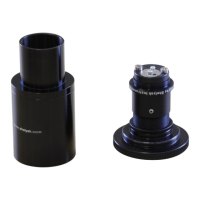5
Next steps
You have now passed all the steps to produce your
first reduced spectra. With experience, you will per-
form the acquisition and data reduction more and
more efficiently. In this section, we’ve put some tips
and tricks to improve your observations. Improved
observations means better data quality (up to pro-
fessional quality level data), and better efficiency (or
productivity) in your observing procedures. Most of
the advice below assumes that you’re working in slit
mode, ie you have a guiding module.
5.1 Improve data quality
5.1.1 Signal / Noise Ratio (SNR)
Star light is faint... and you spread it out with your
spectroscope. At the end of the chain, only a few pho-
tons reach each pixel of your CCD camera. The whole
instrument (telescope, spectroscope, camera) limits
your ability to detect faint signals. The quality of your
spectrum is directly linked to the level of signal you
get on your CCD compared to the “noise” of the in-
strument, which is its limit of detection. This is what
we call the Signal / Noise Ratio (SNR).
Improving SNR can be done in two ways: reduce
the noise or increase the signal.
Reducing the noise is hard: it is limited by physics.
But we can do it to a certain extend. For instance,
by cooling down the camera, you reduce the internal
activity of the CCD, and reduce the noise.
The best way to improve SNR is then to increase
the Signal. It can be done by several ways:
– Increase exposure time (the SNR will be increased
as the square root of the time multiplication fac-
tor),
– Increase the telescope size (this is why all as-
tronomers are always looking for bigger telescopes),
– Ensure that most of the light is going through the
spectroscope. Star images and slits are very small
(a few µm), and it is very easy to lose a high pro-
portion of the light at the instrument.
The two main reasons for losing light at the spectro-
scope entrance are usually:
– Telescope focusing. If the focus is not optimal,
the object size will be bigger than the slit width,
and only some percentage of the object’s light will
enter in the instrument.
– Position of the star in the slit. When working in
slit mode, it is very easy to put the the star partly
outside the slit. The result is the same: you lose a
high percentage of your source.
The best way to improve this point is to check that
when the star crosses the slit (if any), it almost disap-
pears from your guiding image. Carefully tune your
guiding camera exposure time to prevent any satura-
tion.
If the star disappears from the guiding image
when crossing the slit, it means that most of
light is going through the spectroscope.
With the experience, you will know how much signal
your instrument will get for a given magnitude. You
should also compare your data with others with sim-
ilar equipment, as an external reference (see section
5.3). If you see that this level is lower than is usual,
take some time to find the source of this loss.
To go further into SNR improvement, you can mea-
sure the total power of your spectrum, and tune the
telescope focusing to optimize this measurement.
5.1.2 Resolution
If you work in slit mode, the resolution of your
spectrum comes mainly from the spectroscope itself.
The resolving power of the Alpy 600
1
is approximately
R=600 around Hα. The ISIS software calculates the
actual resolving power as part of the data reduction.
Check that your actual result is close to this value.
The resolution is calculated from the width
of the calibration lines (∆λ = FWHM of cali-
bration lines. The better the focus of the calibra-
tion lines, the better is the resolution.
1. Resolution power gives the ability of the spectroscope to see
details. It is calculated as λ/∆λ, where∆λ is the smallest visible
detail in the spectrum.
35

